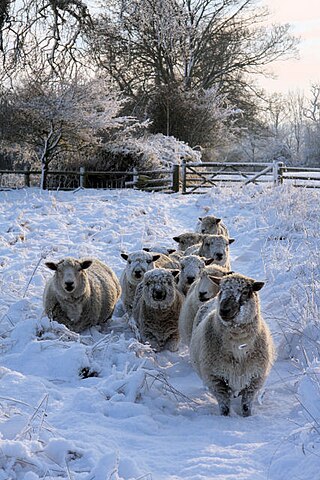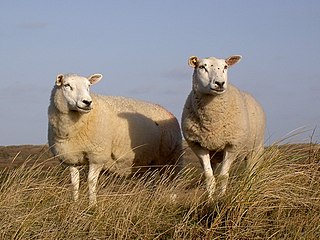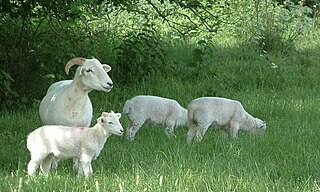History
The Xalda is one of the oldest sheep breeds in Spain. It is first recorded in 27 BCE, by the Greek historian Estruban, who wrote of black tunics being made by the Asturi tribe out of the Xalda's wool. [2] The Xalda likely traces its lineage back to the ancient Ovis aries celticus, [4] and is related to other sheep of Celtic origin, including the Ouessant, the Black Wales, the morite, and several German breeds. [3] Most of its related Iberian ancestors are extinct, [1] with one notable exception being the very rare Bordaleira of Northern Portugal. [4]
The sheep used to be very popular within its native range, with an estimated 6,000 being alive in the 12th century. [2] During its height, the Xalda was an important part of the culture and history of Asturias. [4] However, the breed began to decline in numbers by the 1940s due to abandonment of the countryside in its native range. It also faced competition from specialty dairy breeds, which became popular among cheese makers. [3] Whatever the reason for the decline, by 1980 only 800 purebred Xalda remained, [1] and by the founding of the breeders association in 1992, only 400 purebred animals remained. [2]
Conservation Status
At the height of the breed's population, the Xalda was very widespread in Asturias, with an estimated 6,000 living in the 12th century. [2] However, the breed decreased in popularity due to abandonment of the countryside in its native range and competition from more commercially viable breeds. [3] By the 1980s, only 800 head remained, [3] and by time the breeders association was founded in 1992, there were only 400 Xalda left. [2] However, the founding if the Xalda breeders association in 1992, ACOXA (Asociaciòn de Criadores d'Oveya Xalda) helped the efforts to conserve the breed greatly, although it still suffers from a lack of genetic diversity. [4] Nonetheless, the breed's population has increased greatly in recent years, and numbers around 1,700 today. [2]

The Blackface or Scottish Blackface is a British breed of sheep. It is the most common sheep breed of the United Kingdom. Despite the name, it did not originate in Scotland, but south of the border.

The Cotswold is a British breed of domestic sheep. It originates in, and is named for, the Cotswold hills of the southern midlands of England. It is a large long-woollen sheep, and is kept as a dual-purpose breed, providing both meat and wool.

The Jacob is a British breed of domestic sheep. It combines two characteristics unusual in sheep: it is piebald—dark-coloured with areas of white wool—and it is often polycerate or multi-horned. It most commonly has four horns. The origin of the breed is not known; broken-coloured polycerate sheep were present in England by the middle of the seventeenth century, and were widespread a century later. A breed society was formed in 1969, and a flock book was published from 1972.

The Ryeland is one of the oldest English sheep breeds going back seven centuries when the monks of Leominster in Herefordshire bred sheep and grazed them on the rye pastures, giving them their name. It was introduced into Australia in 1919 and are classified as an endangered breed by the Rare Breeds Trust of Australia and also are one of the nine heritage breeds that were the foundation of the sheep and wool industry in Australia. The Ryeland was one of the breeds used to introduce the poll gene to the Dorset breed in the development of the Poll Dorset. This breed is raised primarily for meat.

The Lonk is a British breed of domestic sheep. It belongs to the group of black-faced hill breeds of northern England, and is found in the hills of the central and southern Pennines of Lancashire and Yorkshire. It is documented from the mid-eighteenth century; a flock book was started in 1905.

The Barbados Black Belly is a breed of domestic sheep from the Caribbean island of Barbados. It is raised primarily for meat. Unlike most tropical sheep, it is highly prolific, with an average litter size of approximately 2.

The Oxford Down is a British breed of domestic sheep. It was developed in the 1830s by cross-breeding of Hampshire Down and Southdown ewes with Cotswold rams. It is reared primarily for meat.

The Texel is a Dutch breed of domestic sheep originally from the island of Texel. It is a heavy and muscular sheep, and produces a lean meat carcass. It is polled, clean-faced and clean-legged, with white face and wool. The fibre diameter of the wool averages about 32 μ, with a staple length of 8–15 cm; it is used mainly for knitting and hosiery wools.

The Shetland is a small, wool-producing breed of sheep originating in the Shetland Isles, Scotland, but is now also kept in many other parts of the world. It is part of the Northern European short-tailed sheep group, and it is closely related to the extinct Scottish Dunface. Shetlands are classified as a landrace or "unimproved" breed. This breed is kept for its very fine wool, for meat, and for conservation grazing.

The Wiltshire Horn is a breed of domestic sheep originally from Wiltshire in southern England raised for meat. The breed is unusual among native British breeds, for it has the unusual feature of moulting its short wool and hair coat naturally in spring, obviating the need for shearing. They are good mothers and have high fertility.

The St Croix is a breed of domestic sheep native to the U.S. Virgin Islands and named for the island of Saint Croix. They are often also called Virgin Island White because those that were imported into North America were selected for white coloration. On the Island of St. Croix, they come in shades of brown, white and black.

The Clun Forest is a breed of domestic sheep originating from the area surrounding the Clun Forest in Shropshire, England. Similar to many of the British breeds of upland sheep, Clun Forest are hardy, adaptable, good foragers, and are long–lived. With sleek heads and wide pelvic structures, Clun Forest ewes lamb easily. The breed has a short to medium–length wool and dark brown faces. They are a multi–purpose animal, kept for meat, wool, and milk. Like other dark faced sheep, Clun produce quality lamb and mutton. However, in contrast to more common meat breeds such as Suffolks, their wool is free of undesirable black fibres and kemp, and is suitable for handspinning. The breed's alert and stylish appearance, together with its reputation for hardiness and fecundity have made it popular with hobby farmers and large commercial flock owners alike. The Official Clun Sheep Breeders Society Show & Sale for males and females is held annually in early September at Ludlow livestock market by McCartneys.

Hog Island sheep are a breed of sheep descended from animals first brought to Virginia's Hog Island in the 18th century. During the 1930s and 1940s, storm conditions forced the island's residents to evacuate, leaving some sheep behind. These sheep adapted to the environment free of human intervention, becoming feral.

The Llanwenog is a breed of domestic sheep originating in Wales. It was developed in the 19th century from the Llanllwni, the Shropshire, Welsh Mountain, and Clun Forest breeds. The Llanwenog's native locale is the Teifi Valley, in western Wales, but it has since spread into other areas. The breed association was formed in 1957. Llanwenogs have black faces and medium-length wool. They have a docile temperament and are known for their profligacy in lambing. The breed has a very placid temperament, is easily handled, easily contained and is well suited to stress free inwintering if necessary. This has important consequences for the health of both the animal and its keeper. This breed is raised primarily for meat.

The Dalesbred is a breed of domestic sheep originating in England. Derived from the Swaledale and Scottish Blackface breeds, the Dalesbred is a northern hill breed distributed in the Yorkshire Dales and into Lancashire. The Dalesbred is genetically distinct from the other northern hill breeds, the Herdwick and Rough Fell.
The Devon Closewool is a British breed of domestic sheep. It is distributed almost exclusively on Exmoor in North Devon, in south-west England. It is raised primarily for meat.
The Small-tailed Han is a breed of sheep native to the Shandong Province of China. It is known for its very high rates of reproduction and extremely high fecundity. Its high rates of reproduction have made it a growing part of China's livestock sector.

The Rouge du Roussillon is an endangered breed of sheep from southern France. It is primarily raised in the French Mediterranean countryside for lamb meat.

The Roux du Valais is an endangered breed of sheep native to Switzerland.

The New Zealand Romney is a New Zealand breed of sheep. It derives from British Romney Marsh stock imported to New Zealand in the nineteenth century, and was established as a separate breed in 1904. It is the most numerous sheep breed in New Zealand.


















